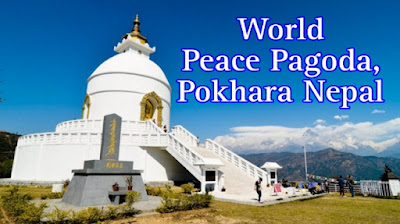World Peace Pagoda|Bishwa Shanti Stupa, Pokhara
World Peace Pagoda | Bishwa Shanti Stupa, Pokhara Nepal
The World Peace Pagoda (Bishwa Shanti Stupa) is a beautiful Buddhist stupa located on a hilltop in Pokhara, Nepal. It was built with the intention of promoting world peace and harmony, and is a popular tourist destination for those seeking a peaceful and serene setting. In this article, I will explain the history, architecture and significance of the World Peace Pagoda of Pokhara in detail.
History of the World Peace Pagoda:
The World Peace Pagoda, also known as the Bishwa Shanti Stupa, was built by a Japanese Buddhist monk named Nichidatsu Fujii in 1973. Fujii was the founder of the Nipponzan-Myohoji Buddhist sect, which is known for its commitment to nonviolence and world peace. Fujii believed that the construction of a Peace Pagoda in different parts of the world could help spread the message of peace and nonviolence, and thus started building Peace Pagodas in different parts of the world.
The construction of the World Peace Pagoda in Pokhara was initiated by Fujii's disciple, Bhikshu Gyomyo Nakamura, who had visited Nepal in the early 1970s. Nakamura was inspired by the natural beauty of Pokhara and felt that it was an ideal location for a Peace Pagoda. He, therefore, approached the Nepalese government and local authorities, who agreed to provide the land for the construction of the Pagoda.
Design and Architecture of the World Peace Pagoda:
The World Peace Pagoda in Pokhara is one of the most beautiful and unique structures in Nepal. It is built in the traditional Buddhist stupa style, which is characterized by its dome-like shape and spire on top. The Pagoda is made of white marble and is adorned with beautiful golden images of Buddha. The dome is surrounded by four smaller domes, which are also adorned with images of Buddha.
The Pagoda is built on a hilltop overlooking the Phewa Lake, and visitors can reach it by climbing a flight of stairs. The view from the Pagoda is breathtaking, and visitors can see the beautiful Pokhara valley and the Annapurna range of mountains in the distance.
Significance of the World Peace Pagoda:
The World Peace Pagoda in Pokhara is not just a beautiful structure, but it also holds great significance for Buddhists and people of other faiths. The Pagoda is seen as a symbol of peace and nonviolence, and it attracts people from all over the world who are seeking spiritual enlightenment and inner peace.
The Pagoda is also a center for interfaith dialogue and cooperation. People from different religious and cultural backgrounds come to the Pagoda to learn about each other's beliefs and to promote understanding and respect. The Pagoda has also been the site of many peace marches and rallies, which have helped raise awareness about issues such as nuclear disarmament and environmental protection.
In addition to its spiritual and cultural significance, the World Peace Pagoda also has practical benefits for the local community. The construction of the Pagoda provided employment opportunities for many local people, and it has become a major tourist attraction in Pokhara, bringing in much-needed revenue for the local economy.
Conclusion:
In conclusion, the World Peace Pagoda in Pokhara is a beautiful and significant structure that promotes peace, understanding, and nonviolence. It is a testament to the power of faith and spirituality in bringing people together and promoting positive change in the world. Whether you are a Buddhist or a person of another faith, a visit to the World Peace Pagoda is sure to leave you with a sense of peace and harmony.








Post a Comment